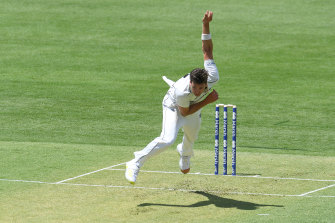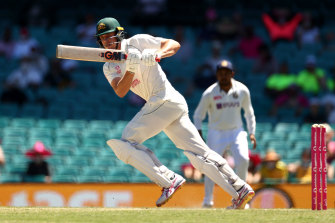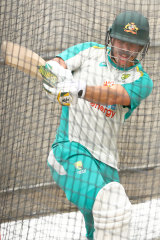Equal parts art and science: the formula to selecting Australia’s first Test team
Greek philosopher Aristotle propounded that the “whole is greater than the sum of its parts”.
Australia’s selectors – George Bailey, Tony Dodemaide and Justin Langer – may soon put that saying to the test, pardon the pun. Evaluating how the parts can make the whole stronger is the core of what selection is all about.
Putting a successful team together is equal parts art and science. The science often gets more recognition than the art, but just following the data has led many selection panels down an endless, dark tunnel.
Sometimes, the easy selection is not the best selection. Looking beyond the obvious is where art trumps science.
Most discussions before the final XI is picked will revolve around two or three spots.
Three of the bowling group for the first Test pick themselves – Pat Cummins, Josh Hazlewood and Nathan Lyon –with the only decision being between Mitchell Starc and Jhye Richardson.
Jhye Richardson bowls during day one of the Sheffield Shield match between Queensland and Western Australia.Credit:Getty
Starc brings the X-factor and on his day he can be devastating and unplayable. Richardson is more predictable; he doesn’t extract Starc’s steepling bounce, though he too generates good pace. He would make the English batsmen play more balls.
As the first two Tests are likely to be low-scoring affairs, a few high-scoring overs might be the difference in Brisbane and Adelaide. But if the captain and coach go for the bolder option of seeking wickets irrespective of runs conceded, Starc gets the nod.
Rotation of the pace bowlers is inevitable because we saw last summer how hard it was for them to get through five Tests, so Starc and Richardson will have roles this series, barring injury.
Now that Paine has stood down, the selectors have made the toughest decision of the summer in naming Cummins his replacement as captain. Some would say finding his replacement as wicketkeeper was nearly as difficult.
In Alex Carey and Josh Inglis, the selectors had two excellent candidates. There is little between them as keepers, and their first-class records as batsmen are a mirror image. The left-handed Carey, who has more flair than Inglis and more international experience, got the gloves.
Five of the six batsmen are lock-ins – David Warner, Steve Smith, Marnus Labuschagne, Marcus Harris and Cameron Green. The rest of the meeting will be spent agonising over one batting spot.
Cameron Green made an impact with the bat in his debut summer for Australia.Credit:Getty
Now to the nitty-gritty: how can the panel improve the whole by analysing what skills are present in the obvious selections and supplementing them with what the rest can bring to the table?
Fortunately, the definite batting selections are all quality players with a wide range of strokes that can put pressure on any bowling side. This means that the selectors can look for complementary skills that will make for good batting combinations.
Batting combinations work best when there is variety on offer. Right- and left-handed pairings are obvious but not imperative. Langer and Matthew Hayden were both left-handers but were a brilliant blend because they had different playing styles.
Warner, despite his most recent form against England in the longer format, is still a pivotal figure in the Australian line-up. The in-form Harris will partner him.
Warner may be a polarising figure for some and many had written him off before the T20 World Cup, only to have him prove how important he is at the top of the order.
I think he is even more important in the Test line-up. A skilful, fast-scoring opener can set the tone. Teams with aggressive openers cause opposition captains and bowlers headaches.
I was lucky to play with Keith Stackpole, whose belligerence put scared opposition teams on notice. The faster the bowlers, the more aggressive Stackpole became. Michael Slater and Hayden played some devastating innings, which made batting much easier for those following.
Stuart Broad had Warner’s measure in England during the 2019 Ashes, where he got him out for fun. He came around the wicket and angled everything into the stumps. The England brains trust figured that coming over the wicket opened up the off-side to a strength of Warner’s, so they cramped him up.
Their default, back-of-length mode of attack only fed Warner’s strength, so they pitched the ball fuller than ever before. Broad bowled superbly, giving him no width or length to work with. Every ball threatened the stumps from around the wicket, so he was forced to play everything.
David Warner will be a key man for Australia.Credit:Getty
If the delivery held its line, his pads and stumps were exposed, and if it straightened to slip, the outside edge was vulnerable. It was no surprise to see him dismissed by Broad, bowled twice, lbw thrice and caught behind twice, trying to withdraw his bat.
Despite his seemingly hypnotic hold over Warner in England, Broad will be aware that bowling in Australia with the Kookaburra ball is very different from bowling in England with the Dukes ball.
The Dukes seam is more prominent than that on the Kookaburra, and it swings appreciably more and for longer.
Warner will relish the extra bounce in Australia; it allows him to generate room to play attacking shots. In England, where the ball didn’t get above bail height, he was hamstrung and found scoring difficult.
Broad will have to pitch the ball much fuller in Australia to threaten the stumps. That will provide the pugnacious left-hander with more scoring opportunities and put the pressure back on the bowler.
Expect an engrossing first spell when the pair duel at the Gabba. Whoever comes out on top during that match-up will give their team the upper hand in the series.
Warner’s aggression and all-round stroke play means that a more circumspect player with fewer attacking options, like Harris, can be considered as a complementary partner. Ed Cowan and Chris Rogers played that role extremely well with Warner in the past.
Usman Khawaja could be also considered for that role, but I feel he is better suited in the middle order, breaking up the right-handers.
The wide range of skills that Smith brings to the arena makes the job of other batsmen much easier. Labuschagne is a good mix with Smith, as he can play either the support role, or take over and lead, should the situation dictate.
Green, the new member of the middle order is an exciting prospect because he adds diversity to the line-up and has a range of strokes down the ground and square off the wicket.
Green is extremely tall, so that adds another element to his combination with other batsmen. His reach makes back of a length balls seem full. That will mess with the bowling teams’ lengths, and shorter batsmen can benefit, if bowlers err or not adjust their lengths quickly.
The other two middle-order options are square of the wicket players. Khawaja and Travis Head both prefer the ball back of a length, so they offer similar skills. Both are solid, rather than brilliant in the field, so the selectors will pick the one they think will handle the England attack best.
Gut feel may be what leads the selectors to their final choice. This is where art takes precedence over the science.
I believe the selectors have got their match-ups right, to maximise the strength of the whole and prove Aristotle’s assertion.
Sports news, results and expert commentary. Sign up for our Sport newsletter.
Most Viewed in Sport
From our partners
Source: Read Full Article



